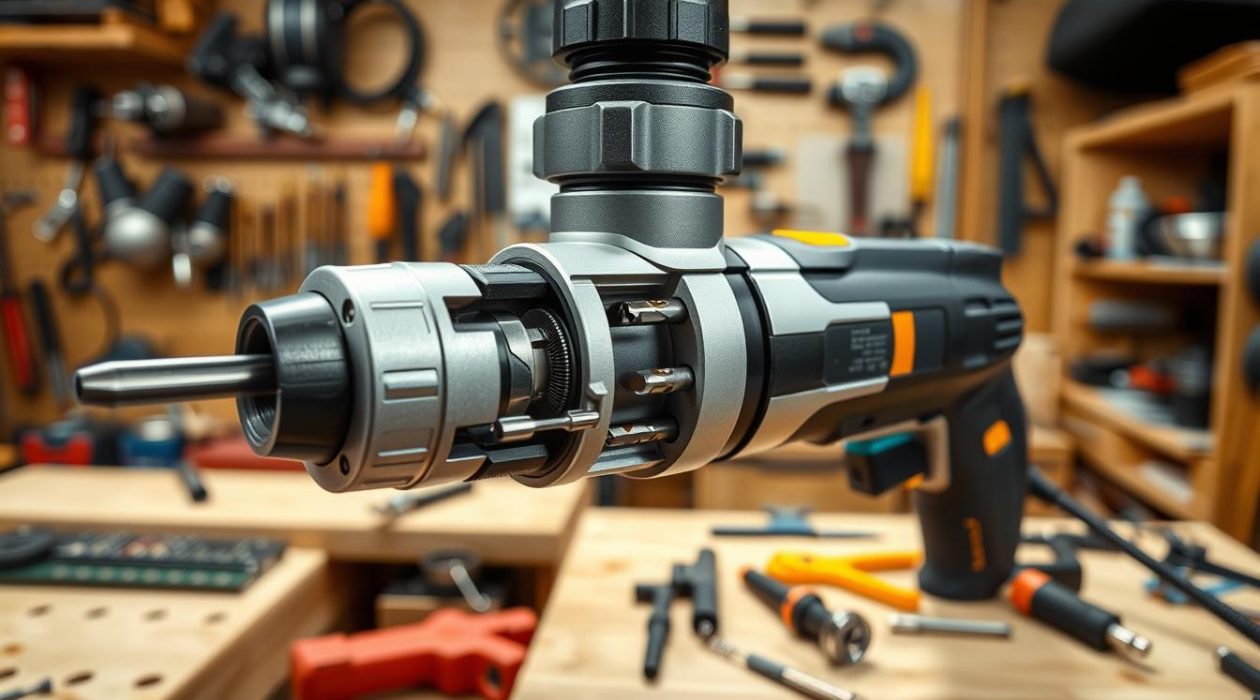Quick-change systems are transforming the use of power tools, enabling fast attachment changes. This innovation saves time, boosts productivity, and enhances efficiency in DIY and professional tasks. It’s all thanks to quick-change attachments and the latest in power tool technology.
At the heart of these systems lies the ability to smoothly switch between tool bits. This makes them an essential part of any toolkit. By embracing quick-change attachments and cutting-edge power tool innovations, users can optimize their workflow. They can then reach their objectives more swiftly and effectively.
Introduction to Quick-Change Systems
Grasping the mechanics and advantages of these systems is vital for anyone aiming to enhance their toolkit. Quick-change systems enable swift attachment swaps, cutting down on idle time and boosting efficiency. This is achieved through the integration of the latest power tool advancements and quick-change attachments.
Key Takeaways
- Quick-change systems save time and increase productivity
- They allow for rapid switching between different attachments
- Quick-change attachments are a key component of these systems
- Power tool innovations have made quick-change systems more efficient
- These systems are ideal for DIY projects and professional tasks
- They streamline the work process and reduce downtime
Understanding Quick-Change Systems and Their Evolution
The evolution of quick-change systems is a tale of innovation, driven by the quest for efficiency in power tool technology. Changing tool bits was once a time-consuming task, hindering workflow. This led to a pressing need for tool innovations that could simplify this process.
As the demand for quicker and more reliable tool changes escalated, manufacturers dedicated themselves to research and development. This effort gave birth to quick-change technology. It marked a significant industry shift, introducing solutions that were both faster and more reliable. This paved the way for further advancements in power tool technology.
The Traditional Tool Change Problem
Changing tools traditionally was cumbersome, requiring a lot of time and effort. This not only slowed down production but also increased the risk of errors and accidents. The evident need for a more efficient system prompted manufacturers to develop quick-change systems. These could be seamlessly integrated into existing power tool technology.
Birth of Quick-Change Technology
The advent of quick-change technology transformed the industry, enabling users to switch tool bits quickly and effortlessly. This innovation significantly boosted productivity, allowing users to complete tasks more efficiently and effectively. As power tool technology evolved, quick-change systems became a crucial component, driving further innovations in the field.
Modern Innovations in Tool Changes
Today, quick-change systems have advanced significantly, incorporating advanced materials and designs that enhance performance and durability. These systems are now a fundamental part of power tool technology, offering numerous benefits. From increased efficiency to improved safety, they play a vital role in shaping the future of power tool technology.
| Year | Innovation | Impact |
|---|---|---|
| 2000 | Introduction of quick-change technology | Increased efficiency and productivity |
| 2010 | Advancements in material design | Improved durability and performance |
| 2020 | Integration of advanced power tool technology | Enhanced safety and efficiency |
Benefits of Quick-Change Systems in Your Workshop
DIY efficiency tools can significantly boost your workshop’s productivity. Quick-change systems are crafted to streamline your DIY projects or professional tasks. They save you time and effort by minimizing the time spent on tool bit changes. This allows you to concentrate more on the task, leading to better results and increased efficiency.
Key advantages of quick-change systems include:
- Reduced downtime: These systems enable swift tool changes, cutting down on downtime.
- Increased productivity: You can finish projects quicker and more efficiently, thanks to more time for the task.
- Improved accuracy: They help reduce errors and enhance precision by ensuring the right tool is used for the job.
Research on workshop efficiency and productivity highlights the significant impact of quick-change systems. For instance, a study by a leading tool manufacturer revealed a 30% increase in productivity.
Incorporating quick-change systems into your workshop can profoundly affect your work. They reduce downtime, boost productivity, and enhance accuracy. This leads to faster and more efficient project completion, making your workshop experience more enjoyable and less stressful. With the right DIY efficiency tools and a focus on workshop productivity, you can elevate your projects to new heights.
| Benefit | Description |
|---|---|
| Reduced downtime | Quick-change systems allow you to switch between tools quickly, reducing the time spent on changing tool bits. |
| Increased productivity | With more time to focus on the task at hand, you can complete projects faster and more efficiently. |
| Improved accuracy | Quick-change systems can help reduce errors and improve accuracy by allowing you to use the right tool for the job. |
Essential Components of Modern Quick-Change Systems
Modern quick-change systems aim to make tool changes seamless. They consist of adapters and connectors, locking mechanisms, and compatibility features. These components are crucial for quick and secure tool changes.
Adapters and Connectors
Adapters and connectors are vital for attaching tool bits to the system. They come in various sizes and types. This allows for compatibility with a wide range of tool bits and brands.
Locking Mechanisms
Locking mechanisms ensure a secure fit, preventing tool bits from loosening during use. They are designed to be easy to use, requiring minimal effort to lock and unlock the tool bit.
Compatibility Features
Compatibility features are essential for working with different tool bits and brands. This is crucial for users with tools from various manufacturers. It allows for easy use of quick-change attachments.
Some key technical specifications of quick-change systems include:
| Component | Description |
|---|---|
| Adapters | Available in various sizes and types |
| Locking Mechanisms | Easy to use and secure |
| Compatibility Features | Compatible with a wide range of tool bits and brands |
Popular Quick-Change Solutions for Different Power Tools
Quick-change systems lead the way in tool innovations. They aim to boost the functionality and efficiency of various power tools. This caters to both DIY enthusiasts and professionals. Whether it’s drill bits or saw blades, these solutions can greatly impact your workflow.
The market is filled with quick-change solutions tailored for specific power tools. Some notable options include:
- Drill bit quick-change systems for easy bit swapping
- Saw blade quick-change systems for fast and secure blade changes
- Router bit quick-change systems for convenient bit changes
These power tool solutions aim to save time and boost productivity. By exploring the different quick-change options, you can pick the best fit for your needs. This ensures you maximize your tool’s potential. With the right system, you can concentrate on your work, not tool changes.
In summary, quick-change systems are essential for any workshop or job site. Investing in the right tool innovations and power tool solutions streamlines your workflow. It increases efficiency and leads to better results.
| Power Tool | Quick-Change Solution |
|---|---|
| Drill | Drill bit quick-change system |
| Saw | Saw blade quick-change system |
| Router | Router bit quick-change system |
Maximizing Efficiency with Quick-Change Attachments
Quick-change attachments are crucial for boosting efficiency in various tasks. They are a must-have for any workshop. By using DIY efficiency tools, one can make their workflow smoother and more productive. The essence of quick-change efficiency is the ability to swiftly swap attachments, cutting down on time and effort.
In different scenarios, quick-change attachments show their worth. For drilling, they enable fast changes between drill bits. This not only saves time but also improves the overall process. For cutting and grinding, they allow for quick transitions between tools, becoming a vital part of any workshop.
- Increased productivity
- Reduced downtime
- Improved workflow
- Enhanced efficiency
The advantages of quick-change attachments are clear. They bring significant benefits to any workshop. By integrating DIY efficiency tools, individuals can directly experience the benefits of quick-change attachments.
| Application | Benefits of Quick-Change Attachments |
|---|---|
| Drilling | Rapid switching between drill bits, increased productivity |
| Cutting and Grinding | Swift transitions between cutting and grinding tools, enhanced workflow |
| Specialty Tools | Convenient and efficient switching between attachments, improved efficiency |
Understanding the benefits of quick-change attachments is key. By incorporating them into their workflow, individuals can significantly boost efficiency. With DIY efficiency tools and quick-change efficiency, the potential for improvement is vast.
Investment Considerations and Cost Analysis
Investing in a quick-change system requires a detailed cost analysis. The initial cost might seem steep compared to traditional methods. Yet, the long-term benefits in time saved and productivity gains can significantly offset these costs.
The durability and reliability of quick-change systems can reduce the need for frequent replacements. This enhances their cost-effectiveness. Cost-benefit analyses reveal that they offer substantial returns on investment, crucial for businesses heavily reliant on power tools.
When assessing the cost efficiency of quick-change systems, several factors are crucial:
- Initial investment cost
- Long-term maintenance and replacement costs
- Increased productivity and efficiency
- Reduced downtime and improved workflow
By examining these elements, businesses can determine if a quick-change system is a sound investment.
| Factor | Traditional Tool-Changing | Quick-Change Systems |
|---|---|---|
| Initial Investment | Lower | Higher |
| Long-term Maintenance | Higher | Lower |
| Productivity and Efficiency | Lower | Higher |
Maintenance Tips for Quick-Change Systems
Regular maintenance is crucial for extending your quick-change system’s lifespan and ensuring optimal performance. By adhering to simple maintenance tips, you can avoid wear and tear, minimize repair needs, and preserve your tool innovations’ efficiency. Understanding the significance of regular cleaning and care is vital.
To maintain your quick-change system’s functionality, adhering to specific cleaning and care guidelines is essential. This involves regular cleaning to prevent dirt and debris buildup, which can cause damage. Also, conducting regular inspections helps identify potential issues early on. By adopting these practices, you can prolong your quick-change system’s life and maintain its efficiency, a cornerstone of tool innovations.
Cleaning and Care Guidelines
- Regularly clean the quick-change system to prevent dirt and debris from accumulating
- Inspect the system regularly to identify any potential issues
- Follow the manufacturer’s instructions for cleaning and maintenance
By adhering to these maintenance tips, your quick-change system will continue to operate at its best. Always refer to the manufacturer’s guidelines for maintenance and repairs. If unsure, professional assistance is available. Proper maintenance ensures the longevity and efficiency of quick-change systems, a key benefit of tool innovations.
Safety Considerations and Best Practices
When using power tools and quick-change systems, safety must be your primary concern. Adhering to best practices and being mindful of hazards can significantly reduce risks. DIY efficiency tools are invaluable, but they must be handled with care and caution.
To safely operate quick-change systems, certain safety practices are crucial. These include:
- Ensuring the tool is properly secured before use
- Keeping loose clothing or long hair tied back
- Being aware of the surroundings and keeping children or pets away from the work area
Adopting these safety measures allows you to harness the advantages of quick-change systems while minimizing risks. Regularly inspecting your tools and systems is also vital. This step helps prevent accidents and maintains a safe workspace.
Remember, safety is a collective responsibility when working with DIY efficiency tools and quick-change systems. Being vigilant about potential hazards and following best practices fosters a safe and efficient work environment.
By prioritizing safety and adhering to best practices, you can maximize the benefits of your quick-change systems and DIY efficiency tools. Always remain focused and alert when using power tools. Never compromise on safety.
Conclusion: Embracing the Future of Tool Efficiency
Quick-change systems mark a major advancement in tool efficiency, offering a convenient, reliable, and productive way to work with power tools. As technology advances, we can look forward to even more innovative solutions that enhance quick-change systems. These advancements will help both DIY enthusiasts and professionals stay at the forefront, enjoying increased efficiency, productivity, and satisfaction in their work. The future of tool efficiency is closely tied to the development and adoption of quick-change systems, making them a valuable investment for anyone looking to upgrade their toolkit.
Power tool brands like Dewalt, Bosch, and Milwaukee are at the forefront with their advanced quick-change systems. These systems seamlessly integrate with their tool lineups, offering greater versatility, faster changeovers, and enhanced performance across various applications. By embracing the future of tool efficiency, you can take your projects and workflows to new levels of productivity and success.



